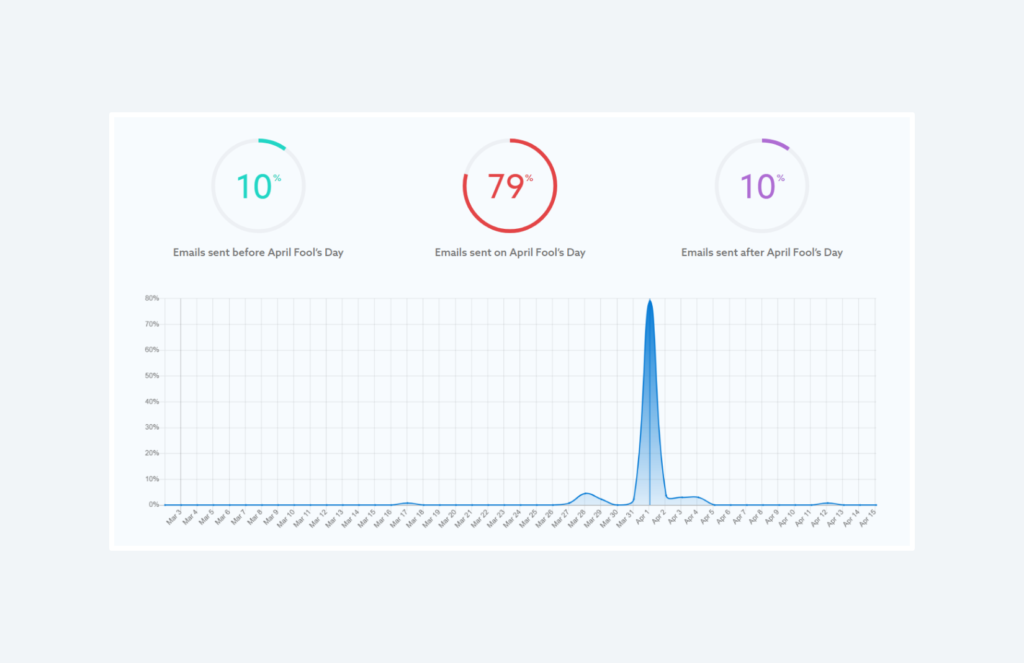April Fools’ Day is the perfect opportunity to show your brand in a more fun light and get some additional traffic. But how to know when the joke went too far? Or should you even be doing it?
It’s the time of the year when you question every little thing people tell you as you might get played. Yes, it’s April Fools’ Day. This is the perfect day to pull a practical joke on your friends and family. It’s also a time for companies to pull ahead in the never-ending race of relevancy. This one time in the year you get to play a joke at your customers’ expense. The only trick: it’s much harder than you think to do this tastefully, without offending anyone, and at the same time stay true to your brand. Today we will talk about all of the aspects of pulling a successful email marketing prank.
Table of Contents
- Using hijack marketing in your April Fools' campaign
- Why should you promote yourself on April Fools’?
- Is it right for your brand?
- When to send your April Fools' campaign?
- How to prank well?
- Know the audience inside and out
- Stay true to your brand
- Check your campaign twice
- Invest time in campaign planning
- Supporting promotions
- 1. Social media
- 2. Email
- 3. Third-party
- What are the risks?
- The strategies for April Fools’
- New product or service
- Fake announcements
- Make it fun
- Discount or a surprise
- Make it a learning experience
Using hijack marketing in your April Fools' campaign
In short, hijack marketing (or real-time marketing) is jumping on the bandwagon of a planned event or spontaneous incident with an already existing audience that will gain you extra attention. The subject of this marketing is so vast that it definitely deserves a standalone article. However, let’s scratch the surface for the sake of clarity.
The biggest difference between traditional sponsored content and hijack marketing is that with sponsored content you can pretty much estimate how many people you will reach. It’s simple math - you boost the article with a specific amount of funds and get a certain number of people to see it. With hijack marketing, there is a difference. You jump on a wave of recent events. It requires great reflexes to do this fast before everyone will get bored with the new meme or news. Your reach can be low or gigantic. There is an element of luck in it, but with practice, you’ll get a feeling of what might work and whatnot.
One of the opportunities that you can take, among other holidays, is April Fools’ Day. This celebration gets so much hype already, building throughout the years, that not participating in it may put you far behind your competition. But, to actually gain valuable, positive traffic, you need to follow the rules. Hijack marketing has some very specific guidelines that include timing, research and sensitivity, and you should follow them for the best possible performance. With the hijack marketing definition behind us, we should move on to the topic at hand - April Fools’ email marketing campaigns.

Why should you promote yourself on April Fools’?
The answer is simple - why not? April Fools’ may not be a typical promotional day such as Christmas or Black Friday, but it certainly has its own special allure. While Christmas is quite an official and elevated holiday, where promotion is usually tasteful and family-oriented, Black Friday campaigns being predominantly sale-directed, and Valentine’s being very cutesy overall, April Fools’ is perfectly neutral. You can join in on the fun with other brands, make a snarky comment or do something wholesome to really let your business shine.
The only thing that limits you is your creativity and a fair dose of sensibility to be a part of the celebration. Furthermore, with a good April Fools’ campaign, your brand awareness will rise, you’ll show a bit of company personality and with a well-made joke, even some shares among other blogs and sites. If you want some hard data to back up this claim, give Ads with the impact a read, where a poll showed that humorous content had a consistent appeal around the world, following real-time situations as a close second. Furthermore, a study conducted states that as long as the humor presented is relevant and of high quality, it has a great potential of improving the reach for brands that use it.
Is it right for your brand?
Before you start planning your next April Fools’ joke, it’s important to figure out if taking part in this holiday is even right for your brand and audience. There are a lot of examples of more serious brands that were able to pull off a lighthearted campaign for the sake of the holiday, but not every brand can take that risk. In order to establish if such a marketing move fits your brand, there are four questions that you need to answer truthfully.
- Do you have enough time to prepare a campaign?
- Will your audience be in tune with the nature of a joke?
- Could the prank backfire and in what way?
- What will this campaign achieve for your company?
The two last questions are the ones you should definitely take under major consideration when planning your campaign; and at the same time, they are the most difficult to answer. It’s easy to make a prank backfire, and honestly, you don’t even need to make a joke to turn your audience against you. There were many companies that made insensitive comments or didn’t address something that quickly lost their relevance among users. Therefore, creating a list of pros and cons might work best in your favor.
The last question is a tricky one. Many companies will wrongly assume that every campaign should translate into the amount of sales or number of customers. But it’s not always the case. April Fools’ Day offers a great lesson to learn. Such campaigns mostly help with creating a buzz around the brand. Their goal is to raise awareness, not exactly sales. That’s why it’s important to not only lose expectations but decide if this is something that will benefit the company.
When to send your April Fools' campaign?
April Fools’ Day campaigns live by different rules than other seasonal marketing. It requires a lot of planning ahead (and lots of going back and forth to perfect the prank) but it shouldn’t be sent in advance. Mailcharts checked the emails that had an “April Fools’ day” key phrase in the title and the result was very straightforward.

What it indicates is that most of the email campaigns are staying relevant by being launched perfectly on time. Rarely, companies decide to send the emails before or after April Fools’. It's mainly due to the fact that the joke might be understood wrongly by their audiences. You might think differently, but joking is a delicate art that needs to be perfected. That’s why it’s better to play it safe where you can and opt-out from pulling pranks on subscribers any other day.
When it comes to pinpointing the exact sending hour, it’s mostly personal. By knowing your audience and actively tracking the email activity, you can establish the optimal time to send your April Fools’ campaign in order to get the best open rate and CTR. This simply requires consistently working with campaigns on a regular basis. The easiest way to do this efficiently is to use a feature that does the job for you. Elastic Email does have a very useful option to send the campaign at the most engaging time. That means less hassle with figuring out when to send the email by yourself.
How to prank well?
When it comes to practical jokes on April Fools’, you can easily take it too far. This could result in a negative buzz around your company. That is why, knowing not only if you can make a prank, but how to do it well is essential for the success of the campaign. Thankfully, when it comes to pulling a brand joke there is a set of specific rules that make this task clearer.
Know the audience inside and out
Don’t shoot in the dark with figuring out how your customers will react to the prank. Have some hard data to back up your campaign instead. Establish a customer profile that will be a baseline for the nature of your joke. Age, gender, location and a rough idea of their interest will give you a good idea of what types of jokes are welcomed and what might be frowned upon. Of course, you won’t have 100% accurate data. For now, there is no possible way to match the joke perfectly to every subscriber. However, such a profile will be of great help with determining how customers will react to the joke and how far you can go before it will turn sour.
Stay true to your brand
You can understand this rule in two ways. First, you need to keep the joke in tune with your company’s culture. Otherwise, the joke will seem forced and might not resonate well with your audience. If your company is edgy, you can allow more “controversial” jokes in your campaign. However, if the brand is more wholesome, the same joke will not fly. You need to align the prank with your brand's voice and online presence for it to work effectively.
The second way is how people view your brand. If the company is usually on the serious side, trying to be funny one time during the year might come off as awkward and forced. If you want to take part in the April Fools' celebration, you need to have fun more times than just on this occasion.
Check your campaign twice
You may be short on time or have a deadline to meet in regard to your campaign. Still, this is the one email you want to check two or even three times before you send it. Verify any typos, how the mobile version looks if the graphics align - make sure everything works seamlessly. Especially, check the content.
Ideally, you should put together the campaign in advance with only some minor adjustments done closer to the launch date. But sometimes, life isn't so perfect and the whole email, idea or campaign needs to be thrown away due to unforeseen circumstances. It may be that the joke became irrelevant or it took a turn that offended some people. This might result in jokes potentially harming the company instead of gaining healthy traffic.
It’s a good idea, in this case, to follow the major trends online to stay vigilant in case of possible issues. Even better is to have at least two different campaigns ready. The first one is relevant to current situations and the second with more classic pranks, to be safe. Having a relevant, accurate and funny joke is the baseline of this campaign being successful, but it’s good to have the backup. Reveal the punchline right away.
The goal of a successful April Fools’ joke is, of course, to get someone to fall for it. But as in real life, also in marketing, leading a person on for too long can have the opposite result to what we hoped for. In order to avoid this, reveal the joke relatively quickly. In my opinion, the best bet is to either launch a campaign with a grand reveal at a certain time or when a person clicks on a specific link.
Note, that from the prank launch to the end, there shouldn't be more than 24 hours. Otherwise, many people might not get the joke or believe it, and you may find yourself in an awkward position to explain your actions. It’s just as in real life if you don’t expose the joke to the person soon enough, they just might believe it’s true. For example, we are still waiting for the Flat Earth Society to reveal that it was, in fact, an April Fools’ Day joke. It’s been 11 years, and it’s no longer that funny.
Invest time in campaign planning
It’s effortless to take an easy route and slap a catchy subject line that will refer to April Fools’ Day, but that technique will not make you memorable. And the end goal is to stand out in the crowd, not be a part of it. So if you want to jump on the prank train at the last minute you can. It just won’t make as much of an impact as creating a thoughtful fully fleshed out campaign.
However, if you want to get recognition, it’s better to plan the campaign ahead of time. Thanks to that, you will have enough time to master the technical aspects as well as perfect the content. Social media is a great guide on finding inspiration for more relevant jokes, while at the same time (as we mentioned before), it’s worth exploring some classics too.

Supporting promotions
Good promotion is the key to making the joke seen by many people. However, there is a catch when it comes to April Fools’ Day. Unlike any other holiday and celebration, you can’t really create hype before the actual day comes. Your promotion technique has to be on point to generate the necessary traffic for the campaign to return the buzz.
1. Social media
Social media is an obvious way to push the joke onto your subscribers. However, in order to make it visible for all, you will probably need to dedicate some of the media funds to boost the posts. Additionally, a lot of social media channels now have a highlight option that shows a picture or video for only 24 hours. This is also a great way to showcase your prank without remembering to take it down when the occasion ends.
2. Email
It is a fool-proof way to reach all your subscribers on the 1st of April. A catchy subject line and a carefully crafted email will create a successful prank. However, make sure that your joke doesn’t end with one email only. The best way is to set up a campaign that will launch as early as possible (to be the first to pull a prank) with multiple emails to later explain the joke. Better yet, set up automation to make sure everything will be sent on time.
3. Third-party
The best pranks are when a bunch of people mobilize to do it. So if you have any partnerships with other companies, blogs, social media channels or if you have freelance friends that could get in on the prank, do so! With additional hands, you can truly make a convincing joke with common effort. After April Fools’ Day is over, such connections can be beneficial for your company growth. Besides, it’s good to build better connections, regardless of the market.
What are the risks?
You have to be aware that making a joke on April Fools' Day is not just a fun, lighthearted time. There are some dangers along the way as well so it’s important to be aware of them.
Even with a well-thought-out prank, there might be some people that just won’t appreciate it. Of course, good practice would be to make sure that people understand - you're laughing with them, not at them. You might still experience some sour players that are not having fun with you. This could potentially result in losing a few subscribers or create some negative traffic. But if your joke was created with care, it’s more likely that those people will be viewed as non-team players.
On the other hand, a tone-deaf joke could hurt someone's feelings and hit in a sensitive place. As mentioned before, you should always double or even triple check if the prank won’t bring any damage to your brand or to other people's feelings. Publishing an insensitive joke could be hard to fix later on. One example of a bad joke would be the West Elm promotional campaign. They sent an email to all of their subscribers with a fake receipt for their purchase. Granted, the receipt had things on the list like “that sofa you’ve been eyeing” which probably is not a real item name. Still, seeing in your inbox a confirmation from a shop you did not order anything from recently is in poor taste.
There is one more issue that you might have to face, and it will be a hard one to swallow. Your joke might just not be funny enough. There is no fixed way of creating a great April Fools’ joke. It takes experience, a natural sense of humor and skill to make it memorable and funny. Without these things, instead of making a joke, you might be accidentally making a fool out of yourself. There is a small upside in regard to this though. With the right angle, you can turn it into a promotion, laughing at yourself. Showing you don’t always take yourself seriously which can result in gaining some good buzz. And if you really want to make sure that your joke is funny for others, share it with your coworkers and friends to watch their reactions, and take note.
All of the above risks have one final repercussion - lost trust. It’s easy to pick yourself up and dust off some negative comments. It’s way harder to regain the trust that users lost through such a silly thing as one campaign. That’s why if you decide to take part in the worldwide prank celebration you need to be aware of the impact your campaign could have.
The strategies for April Fools’
When you know all the pros and cons of launching an April Fools’ Day campaign, there is one last question left to answer. What campaign to make? Well, wonder no more, as we’ve put together a list of ideas worth exploring and getting inspired by.
New product or service
One of the classic pranks most brands make is creating a new product or service that will wow your customers. The weirder the better. One of the truly old-school pranks was made by Google. Google is, by the way, a really good source of inspiration for April Fools'. In 2006 Google launched a new feature that supposedly provided the smell of websites. Encouraging people to put their noses closer to the screen in order to smell the fragrance of each website they searched for.
It was harmless, fun and a very well received prank. Bonus and innovation points would be added if a product or service you want to launch was actually created. This, however, requires more time and resources, so it could be a missed idea for small companies.
Fake announcements
This one could be linked to the first scenario when brands make announcements to promote a “fake” product. But it could also be a joke on its own. For example, if you are an Email Service Provider, why don’t you pull a prank announcing a new, revolutionary attachment transfer system? How about pigeons taking care of transferring the files instead? The idea is so out there and silly, that it will quickly be recognized as a joke. Just remember to always inform them that it is a prank, so people won’t flood your customer service with questions!
Make it fun
Who says that pranks should only be pulled to trick people? You can tap into a whole different market by creating a cute one-time minigame in your email (using AMP, for example) or even on your page. Again showing Google as an example, in 2018 they created a minigame inspired by a series of books. Five classic "Where's Waldo" scenes were hidden over Google Maps. Finding Waldo in each scene rewarded the player with a hint as to finding the next one. Completing all the levels unlocked a secret sixth scene on the Moon, which could be accessed by zooming out in the Satellite view. Sadly, Google revealed it as a prank later on and deactivated the game. I wish they didn't as it was a lot of fun!

Discount or a surprise
One thing that can bring some traffic to your page is to give people an offer they cannot refuse. It can be an out of this world discount or giveaway. Just remember the rules. It either has some fine print added to it or is so out there that it’s hard to believe.
Create an insane 80% discount for all products which have to be purchased within the first 5 minutes of receiving this email. Add fine print that it's eligible only for people named John and age 33. Make the requirements intentionally impossible to meet but don’t leave your customers with that, as you could receive some backlash. For all the clicked links, offer a smaller but real discount or a free item to wipe away the tears.
If you want to launch a giveaway, make it timed. Create a rushed atmosphere (add a 24-hour timer if you can) and make the item outlandish. It could be a mini pony or a giant teacup. You can make it something related to the services or products you offer. Just make sure that the link guides customers to an April Fools’ landing page. Also, a word of caution - be prepared that even with a bolded announcement that it’s a joke, some still might take it seriously.
Make it a learning experience
Pranks don’t always need to be solely for laughs. Some can build awareness or have educational purposes. Take an example from Uber that launched an email campaign announcing their new service - UberLIONS. It promoted an on-demand playtime with lion cubs and a delivery right to your doorstep. However, when users clicked on the link, it directed them to the National Geographic fund to help save wild cats.
The pranks can be promoting any cause that your company supports to raise awareness. Additionally, nobody would be upset with a campaign like that as it comes from the goodness of the heart rather than personal gain.

The last few tips I can give you are more overall good practices to follow in order to make an April Fools’ campaign run smoothly. April 1st is a great holiday to have some fun, but it’s important to note that everything needs to come to an end. As long as you keep those 3 points in mind you'll finish the 1st of April strong.
- Create a landing page for your prank, send the email campaign to lead up to it, and if you do that, remember to replace the landing page later with an explanation of the joke. Also, all the offers and promotions made during that day should be timed and later revealed as jokes. Otherwise, people could get confused, or worse - upset.
- Make sure to thank people for taking part in the prank. Some may not be very happy that they got fooled. It’s best to send them some good-natured messages after everything is done.
- If you promoted the prank on any other social media channel or collaborated with another company or blog, make sure to update the information about the prank everywhere. Not everybody is using all communication channels. If you just send an email with the reveal, they might miss it.







